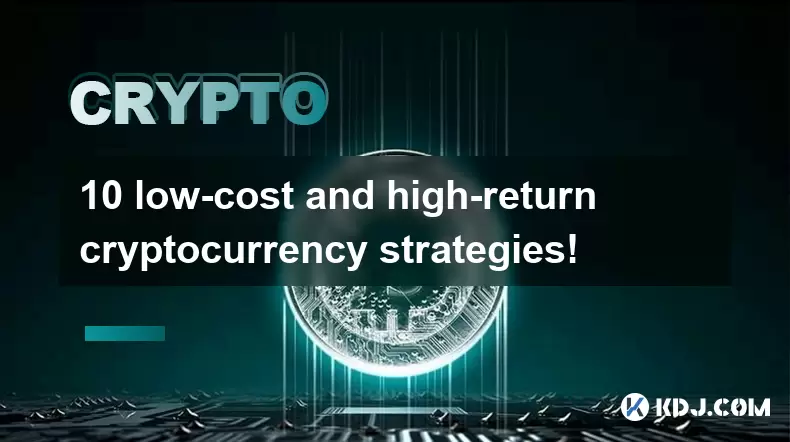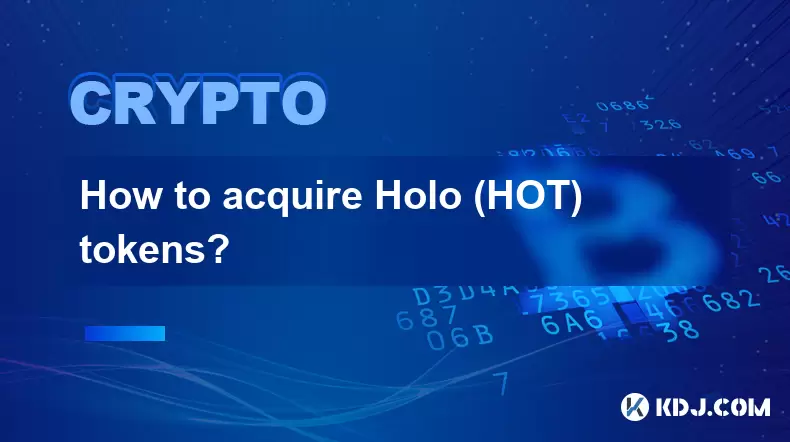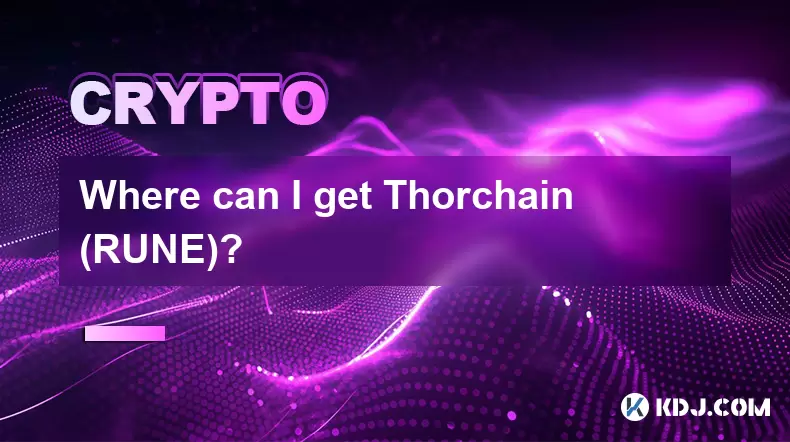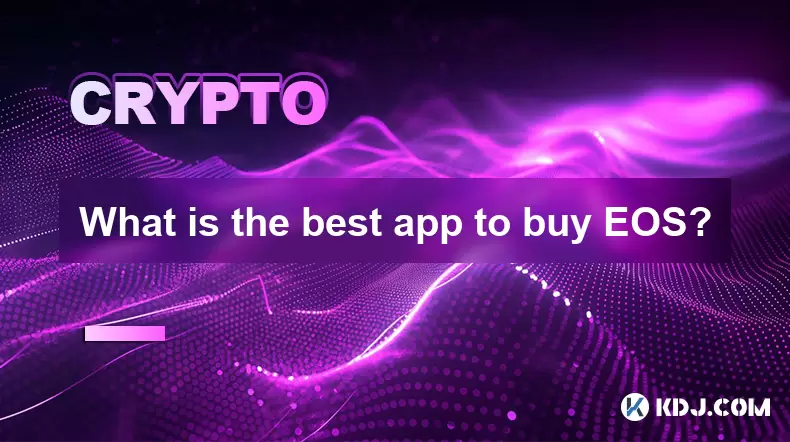-
 Bitcoin
Bitcoin $117500
2.15% -
 Ethereum
Ethereum $3911
6.19% -
 XRP
XRP $3.316
10.79% -
 Tether USDt
Tether USDt $1.000
0.01% -
 BNB
BNB $787.2
2.24% -
 Solana
Solana $175.2
4.15% -
 USDC
USDC $0.9999
0.00% -
 Dogecoin
Dogecoin $0.2225
8.40% -
 TRON
TRON $0.3383
0.28% -
 Cardano
Cardano $0.7868
6.02% -
 Stellar
Stellar $0.4382
9.34% -
 Hyperliquid
Hyperliquid $40.92
7.56% -
 Sui
Sui $3.764
7.63% -
 Chainlink
Chainlink $18.48
10.66% -
 Bitcoin Cash
Bitcoin Cash $582.1
1.88% -
 Hedera
Hedera $0.2601
6.30% -
 Avalanche
Avalanche $23.33
4.94% -
 Ethena USDe
Ethena USDe $1.001
0.02% -
 Litecoin
Litecoin $122.3
2.04% -
 UNUS SED LEO
UNUS SED LEO $8.969
-0.27% -
 Toncoin
Toncoin $3.339
0.86% -
 Shiba Inu
Shiba Inu $0.00001287
4.30% -
 Uniswap
Uniswap $10.43
7.38% -
 Polkadot
Polkadot $3.861
5.08% -
 Dai
Dai $1.000
0.02% -
 Bitget Token
Bitget Token $4.513
3.41% -
 Monero
Monero $267.7
-6.18% -
 Cronos
Cronos $0.1499
4.14% -
 Pepe
Pepe $0.00001110
5.15% -
 Aave
Aave $284.9
8.28%
10 low-cost and high-return cryptocurrency strategies!
Explore 10 effective crypto strategies: DCA, staking, yield farming, arbitrage, HODLing, mining, ICOs, trading bots, airdrops, and lending for low-cost, high-return investments.
May 30, 2025 at 02:57 am

In the dynamic world of cryptocurrencies, finding strategies that offer both low cost and high return can be a game-changer for investors. This article will explore ten effective strategies that have proven successful for many in the crypto community. Each strategy will be detailed to help you understand how to implement them and what to expect in terms of potential returns.
Strategy 1: Dollar-Cost Averaging (DCA)
Dollar-Cost Averaging (DCA) is a strategy that involves investing a fixed amount of money at regular intervals, regardless of the market's condition. This approach reduces the impact of volatility and can lead to significant returns over time.
To implement DCA, follow these steps:
- Determine a fixed amount of money you can comfortably invest.
- Choose a cryptocurrency or a basket of cryptocurrencies.
- Set a regular schedule for investing, such as weekly or monthly.
- Automatically invest the fixed amount at the chosen intervals.
DCA is particularly effective for those new to cryptocurrency investing, as it mitigates the risk of investing a large sum at a peak price.
Strategy 2: Staking
Staking is a process where you hold funds in a cryptocurrency wallet to support the operations of a blockchain network. In return, you receive rewards, often in the form of additional cryptocurrency.
To start staking, you should:
- Choose a cryptocurrency that supports staking, such as Ethereum 2.0 or Cardano.
- Acquire the necessary amount of the cryptocurrency.
- Use a compatible wallet that supports staking.
- Delegate your tokens to a validator node or run your own node.
Staking can offer returns ranging from 5% to 20% annually, depending on the network and the amount staked.
Strategy 3: Yield Farming
Yield farming involves lending your cryptocurrency to decentralized finance (DeFi) platforms to earn interest or other rewards. This strategy can be highly lucrative but comes with higher risks.
To engage in yield farming:
- Research and choose a reputable DeFi platform.
- Deposit your cryptocurrency into the platform's liquidity pool.
- Monitor your investments and adjust as necessary to maximize returns.
Yield farming can yield returns of up to 100% annually, but it's crucial to understand the risks involved, such as smart contract vulnerabilities.
Strategy 4: Arbitrage Trading
Arbitrage trading involves buying a cryptocurrency on one exchange where the price is low and selling it on another where the price is higher. This strategy can be low-cost and high-return if executed correctly.
To perform arbitrage trading:
- Monitor prices across multiple exchanges.
- Identify price discrepancies for the same cryptocurrency.
- Buy the cryptocurrency on the lower-priced exchange.
- Transfer the cryptocurrency to the higher-priced exchange.
- Sell the cryptocurrency to realize the profit.
Arbitrage trading requires quick execution and low transaction fees to be profitable.
Strategy 5: Long-Term Holding (HODLing)
Long-term holding, or HODLing, involves buying and holding onto a cryptocurrency for an extended period, typically years. This strategy is based on the belief that the value of the cryptocurrency will increase significantly over time.
To implement HODLing:
- Research and select cryptocurrencies with strong fundamentals and growth potential.
- Invest in these cryptocurrencies and hold them in a secure wallet.
- Resist the temptation to sell during market downturns.
HODLing has proven successful for early investors in cryptocurrencies like Bitcoin and Ethereum, who have seen exponential growth over the years.
Strategy 6: Crypto Mining
Crypto mining involves using computer hardware to solve complex mathematical problems to validate transactions on a blockchain. Miners are rewarded with cryptocurrency for their efforts.
To start mining:
- Choose a cryptocurrency to mine, considering factors like profitability and hardware requirements.
- Invest in the necessary mining hardware, such as ASICs or GPUs.
- Set up the mining software and join a mining pool for increased chances of earning rewards.
- Monitor your mining operations and adjust as needed to optimize performance.
Mining can be profitable, especially for those who can access low-cost electricity and efficient hardware.
Strategy 7: ICO Investments
Initial Coin Offerings (ICOs) are a way for new cryptocurrency projects to raise funds by selling tokens to early investors. Investing in promising ICOs can lead to high returns if the project succeeds.
To invest in ICOs:
- Research upcoming ICOs and evaluate their whitepapers, team, and potential.
- Participate in the ICO by sending funds to the specified address.
- Hold onto the tokens until they are listed on exchanges or until the project achieves significant milestones.
ICO investments can be risky, but they have the potential for substantial returns if the project is successful.
Strategy 8: Trading Bots
Trading bots are automated software programs that trade cryptocurrencies based on predefined algorithms. They can execute trades faster and more efficiently than humans, potentially leading to higher returns.
To use trading bots:
- Choose a reputable trading bot platform.
- Set up the bot with your preferred trading strategy and parameters.
- Monitor the bot's performance and adjust settings as necessary.
Trading bots can help you take advantage of market opportunities 24/7, but it's essential to understand the risks and ensure the bot is operating as intended.
Strategy 9: Airdrops and Bounties
Airdrops and bounties are methods used by cryptocurrency projects to distribute tokens to users for free or in exchange for specific tasks. Participating in these can yield low-cost, high-return opportunities.
To take advantage of airdrops and bounties:
- Follow cryptocurrency news and social media to find ongoing airdrops and bounties.
- Complete the required tasks, such as joining a Telegram group or sharing a tweet.
- Claim your tokens and hold onto them or sell them for profit.
Airdrops and bounties can be an excellent way to acquire new tokens at no or low cost.
Strategy 10: Crypto Lending
Crypto lending involves lending your cryptocurrency to borrowers in exchange for interest. This strategy can provide steady returns with relatively low risk compared to other crypto investments.
To start lending your cryptocurrency:
- Choose a reputable crypto lending platform.
- Deposit your cryptocurrency into the platform.
- Set the terms for your loans, such as interest rate and duration.
- Monitor your loans and withdraw your funds plus interest when the loans are repaid.
Crypto lending can offer returns ranging from 5% to 15% annually, depending on the platform and the terms of the loans.
Frequently Asked Questions
Q: Can these strategies be combined for better results?
A: Yes, many investors combine multiple strategies to diversify their portfolios and potentially increase their returns. For example, you might use DCA to invest in a cryptocurrency, then stake or lend those assets for additional income.
Q: Are these strategies suitable for beginners?
A: Some strategies, like DCA and HODLing, are more suitable for beginners due to their simplicity and lower risk. More advanced strategies like yield farming and trading bots require a better understanding of the market and come with higher risks.
Q: How important is it to diversify across different cryptocurrencies when using these strategies?
A: Diversification is crucial in cryptocurrency investing to mitigate risk. By spreading your investments across different cryptocurrencies, you can reduce the impact of a single asset's poor performance on your overall portfolio.
Q: What are the tax implications of these strategies?
A: The tax implications vary by country and depend on the specific strategy. For example, staking and yield farming rewards may be considered taxable income in some jurisdictions. It's essential to consult with a tax professional to understand the implications in your area.
Disclaimer:info@kdj.com
The information provided is not trading advice. kdj.com does not assume any responsibility for any investments made based on the information provided in this article. Cryptocurrencies are highly volatile and it is highly recommended that you invest with caution after thorough research!
If you believe that the content used on this website infringes your copyright, please contact us immediately (info@kdj.com) and we will delete it promptly.
- Tron's Sell-Off Spurs Altcoin Shift: What's Next for TRX?
- 2025-08-08 08:30:12
- RUVI Presale: Is the Growth Potential Real?
- 2025-08-08 09:10:12
- Sleep Token's US Takeover: Thornhill Rides the 'Even In Arcadia' Wave
- 2025-08-08 08:30:12
- FTT Token's Wild Ride: Creditor Repayments vs. Market Drop - A New Yorker's Take
- 2025-08-08 07:10:12
- Floki Crypto Price Prediction: Riding the Robinhood Rocket or Just a Meme?
- 2025-08-08 07:15:12
- EigenLayer, Restaking, and Ethereum: Navigating the Hype and the Hazards
- 2025-08-08 06:30:12
Related knowledge

Where can I buy UMA (UMA)?
Aug 07,2025 at 06:42pm
Understanding UMA and Its Role in Decentralized FinanceUMA (Universal Market Access) is an Ethereum-based decentralized finance (DeFi) protocol design...

Where can I purchase Siacoin (SC)?
Aug 08,2025 at 11:14am
Understanding Siacoin (SC) and Its Role in the Sia NetworkSiacoin (SC) is the native cryptocurrency of the Sia decentralized cloud storage platform, a...

What exchanges support buying IOTA (MIOTA)?
Aug 07,2025 at 09:58pm
Understanding the Role of Private Keys in Cryptocurrency SecurityIn the world of cryptocurrency, private keys are the cornerstone of ownership and con...

How to acquire Holo (HOT) tokens?
Aug 08,2025 at 05:56am
Understanding Holo (HOT) and Its EcosystemHolo (HOT) is a cryptocurrency token associated with the Holo ecosystem, which is built on the Holochain fra...

Where can I get Thorchain (RUNE)?
Aug 08,2025 at 08:07am
Understanding the Role of Seed Phrases in Cryptocurrency WalletsA seed phrase, also known as a recovery phrase or mnemonic phrase, is a critical compo...

What is the best app to buy EOS?
Aug 07,2025 at 04:35pm
Understanding EOS and Its Role in the Cryptocurrency EcosystemEOS is a blockchain platform designed to support decentralized applications (dApps) with...

Where can I buy UMA (UMA)?
Aug 07,2025 at 06:42pm
Understanding UMA and Its Role in Decentralized FinanceUMA (Universal Market Access) is an Ethereum-based decentralized finance (DeFi) protocol design...

Where can I purchase Siacoin (SC)?
Aug 08,2025 at 11:14am
Understanding Siacoin (SC) and Its Role in the Sia NetworkSiacoin (SC) is the native cryptocurrency of the Sia decentralized cloud storage platform, a...

What exchanges support buying IOTA (MIOTA)?
Aug 07,2025 at 09:58pm
Understanding the Role of Private Keys in Cryptocurrency SecurityIn the world of cryptocurrency, private keys are the cornerstone of ownership and con...

How to acquire Holo (HOT) tokens?
Aug 08,2025 at 05:56am
Understanding Holo (HOT) and Its EcosystemHolo (HOT) is a cryptocurrency token associated with the Holo ecosystem, which is built on the Holochain fra...

Where can I get Thorchain (RUNE)?
Aug 08,2025 at 08:07am
Understanding the Role of Seed Phrases in Cryptocurrency WalletsA seed phrase, also known as a recovery phrase or mnemonic phrase, is a critical compo...

What is the best app to buy EOS?
Aug 07,2025 at 04:35pm
Understanding EOS and Its Role in the Cryptocurrency EcosystemEOS is a blockchain platform designed to support decentralized applications (dApps) with...
See all articles

























































































